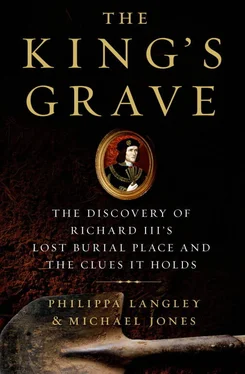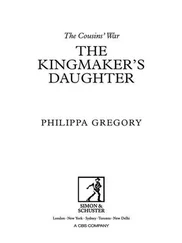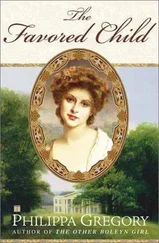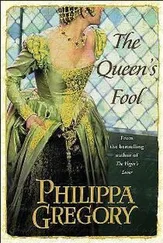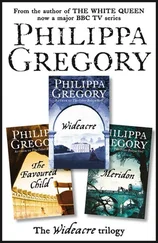After Bosworth, I headed to Leicester. I wanted to explore the city and see it as Richard might have done. To view the remains of the castle, visit the site of the Blue Boar Inn, walk the Western Gateway and cross Bow Bridge over the River Soar, returning via Richard’s statue and the cathedral and, finally, to the New Street car park, where it was rumoured that Richard’s grave might once have been from a fragment of medieval wall that remained there. After visiting the cathedral, and laying my Yorkist white rose on the ledger stone to his memory in the choir, I wandered over to New Street, a small lane opposite. As I crossed St Martin’s the street names around it bore witness to the friary precinct that had once existed nearby: Richard had reputedly been buried in the Church of the Greyfriars in 1485; Friar Lane ran along New Street’s southern end, with Grey Friars Street running off to the east.
New Street car park is a tarmacked expanse of wasteland accommodating a hundred or so vehicles. That warm afternoon it lay almost empty and quiet, giving me the opportunity to walk its length and ponder what might lie beneath the unpromising surface. As I approached the parking attendant’s hut by an old beech tree, I could see the section of medieval stonework lodged in the wall. I tried to get a feel for what it would have been like in Richard’s day, how it might have looked, but nothing remained here of the past. I felt no resonance with Richard’s life, or death.
Leaving New Street to head home, I spotted another car park almost directly opposite. I hadn’t noticed it before, but I’d been so intent on getting to the first car park that I must have walked straight past it. This one had high green gates with a barrier over the entrance and a sign marked ‘Private’. I was going to move on but experienced an overwhelming urge to enter. I slid around the barrier and into the car park which, again, was pretty much deserted apart from a few scattered vehicles. It was a large open space for seventy or more vehicles, surrounded by Georgian buildings with a large red-brick Victorian wall running north to south straight ahead of me. I found myself drawn to this wall and, as I walked towards it, I was aware of a strange sensation. My heart was pounding and my mouth was dry – it was a feeling of raw excitement tinged with fear. As I got near the wall, I had to stop, I felt so odd. I had goose-bumps, so much so that even in the sunshine I felt cold to my bones. And I knew in my innermost being that Richard’s body lay here. Moreover I was certain that I was standing right on top of his grave.
Back home and trying to comprehend what I had experienced, friends and family told me not to dismiss it. A year later, after completing the first draft of my screenplay, I returned to the car park, questioning if what I had felt that day had been real. As I walked to the same spot and looked at the Victorian wall, the goose-bumps reappeared. I stared down at my feet. Slightly to my left, on the tarmac, there was something new – a white, hand-painted letter ‘R’, denoting a ‘reserved’ parking spot, but it told me all I needed to know.
My return visit to a Leicester car park was intended to mark the end of my investigation into Richard’s story but would now mark the beginning of an entirely new search to uncover the real Richard III.
My quest for the king’s grave had started.
IF MY GUT instinct was correct, how did the medieval Greyfriars Church become a modern car park? Most historical sources agreed that following his death in 1485 at the Battle of Bosworth, King Richard III had been buried at the Church of the Greyfriars in Leicester, and ten years later Henry VII had paid for a tomb. Further investigation revealed that in 1538 at the Dissolution of the Monasteries the church was closed and fell into ruins. By 1611, the map maker John Speed reported the place was ‘overgrown with nettles and weeds’ and King Richard’s grave ‘not to be found’. But it is also known that Robert Herrick, a former Mayor of Leicester, had bought part of the Greyfriars site and built himself a mansion. In 1612 Christopher Wren, father of the famous architect, noted that in Herrick’s garden there was ‘a handsome stone pillar’, three feet tall, inscribed with: ‘Here lies the body of Richard III some time King of England’. The Greyfriars site subsequently passed through several owners until, in the early twentieth century, it was tarmacked over to become car parks. Later, part of it was sold to Leicester City Council Social Services Department and it had been in its car park that I had had my unsettling experience.
As I continued to flesh out Richard’s character for revised drafts of my screenplay, the conclusion to his story started to frustrate me. He was the last English warrior king, but had no known grave. Any search for that grave would be fanciful and irrational, particularly since stories abounded about his bones being removed at the Dissolution of the Monasteries and thrown into the River Soar. There was also the question mark over the Greyfriars Church: where was it? Furthermore, supposing human remains were found, how could they be identified as those of Richard III?
Then, everything changed.
Dr John Ashdown-Hill, historian, genealogist and member of the Richard III Society, made a most remarkable discovery. Having traced an all-female line of descent from Richard’s elder sister, Anne of York, to Joy Ibsen, an elderly lady living in Canada, he identified King Richard’s mitochondrial DNA sequence. It was a rare one. Only 17 per cent of the population had haplogroup ‘J’ for Jasmine, but, further, only 1.5 per cent had this particular haplotype, JIC2C.
The science was compelling. Female mitochondria are the most plentiful DNA in the human body. Deoxyribonucleic acid (DNA) is the hereditary material present in all cells of living organisms and the main ingredient of our chromosones, giving us our distinctive genetic characteristics. We each receive our mtDNA from our mother but it is only passed on through the female line, from mother to daughter. Having the mtDNA sequence of Richard III was crucial, since it represented the best opportunity for the survival of DNA within ancient remains because of its quantity, and also offered the greatest potential for a positive identification. The fact that it was a rare type of mtDNA was an added bonus. In addition, the female line of descent is generally considered more trustworthy than the male, because the official, named mother of a child is usually the child’s authentic biological mother.
But how, and why, had the DNA discovery come about? Ashdown-Hill had been working with leading DNA expert Professor Jean-Jacques Cassiman at the Centre for Human Genetics, University of Leuven, Belgium, to try to establish whether bones found in Mechelen in the mid-twentieth century could be the remains of Margaret of Burgundy (1446–1503), an elder sister of Richard III. In the mid-twentieth century, three sets of bones had been discovered and Ashdown-Hill’s research had concluded that one of these might be those of Margaret. He now needed to compare Joy Ibsen’s mtDNA with that in the ancient bones; a match would confirm the remains as those of Richard’s sister. There was only one problem: some time in the past, one set of bones had been coated with varnish as a preservative, making it impossible to isolate DNA, while the other sets may have been contaminated by handling over the years.
Although Ashdown-Hill was unable to extrapolate the ancient mtDNA from the Mechelen bones to identify them, it was a game-changing discovery. I now knew that if we did go in search of King Richard’s body, we would be able to identify him. In autumn 2005 I contacted Ashdown-Hill, and suggested he write to Time Team, the archaeological TV show, proposing a search for Richard’s grave in the Social Services car park. Time Team replied that their three-day dig format was not compatible with a search of such a large area. Of course, I couldn’t tell them (or Ashdown-Hill) why I felt that three days might just be enough.
Читать дальше
